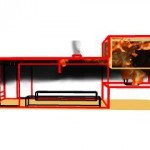Computer-Based Fire Fighter Training Project
By Christopher J. Naum, SFPE on Feb 01, 2012 with Comments 0
Computer-Based Fire Fighter Training Project
Through this project, the Fire Research Division at NIST is developing a computer based fire fighting training tool to improve training opportunities while lowering the cost and risk of death and injury. Two methods are being used to create a training tool. The first and simpler method is to use FDS and Smokeview to create animations of fire scenarios. These animations will be viewable in a standard DVD player. The DVD menus will be used to walk a fire fighter through a series of decisions. The second method is more interactive, and allows the trainee to “walk” through an FDS generated fire scene, using Smokeview, observing and making decisions.
WHAT ARE FDS AND SMOKEVIEW?
 FDS is a computational fluid dynamics (CFD) model of fire-driven fluid flow. The software solves numerically a form of the Navier-Stokes equations appropriate for low-speed, thermally-driven flow with an emphasis on smoke and heat transport from fires. Smokeview is a visualization program that is used to display the results of an FDS simulation. FDS and Smokeview are available for downloading at: http://fire.nist.gov/fds/
FDS is a computational fluid dynamics (CFD) model of fire-driven fluid flow. The software solves numerically a form of the Navier-Stokes equations appropriate for low-speed, thermally-driven flow with an emphasis on smoke and heat transport from fires. Smokeview is a visualization program that is used to display the results of an FDS simulation. FDS and Smokeview are available for downloading at: http://fire.nist.gov/fds/
NIST FDS and Smokeview will be used as a basis for developing a virtual reality based fire fighting training tool. As a fire simulation unfolds, a series of natural break point will be encountered where the trainee will be asked questions such as: Should the window be opened? Should the door be closed? Should the hose stream be opened? The simulation will continue based on the answers provided. These questions will be designed to teach the trainee about tactics relevant to fire fighting such as the effect ventilation on fire spread. Since FDS cannot yet perform calculations in real time, simulations will be pre-computed for all possible question outcomes. Smokeview will be enhanced to be able to “jump” from one scenario to another according to the trainee’s responses.
To do this, the Fire Research Division will take the results from countless live-fire experiments, then use the data from these experiments to simulate and visualize typical fire fighter training scenarios using fire modeling and visualization software (FDS and Smokeview), in order to create effective fire fighter training tools. This will all take place in three major phases:
- Phase 1 – Create illustrations and animations using FDS and Smokeview illustrating basic fire and smoke flow behavior encountered when fire fighting.


Door Closed Door Open


Door Closed, Roof Vented Door Open, Roof Vented
- Phase 2 – Create computerized training environments illustrating various venting strategies and suppression effectiveness for several building types (townhouse, ranch house, training tower)




- Phase 3 – Allow the trainee to interact with the training environments created in Phase 2.
WHY IS THIS IMPORTANT?
Arguably, the most effective method for teaching fire fighters how to do their job is through live training evolutions. This, however, is expensive and particularly dangerous for the trainee. In particular, some fire situations that must be trained for are too large and dangerous to recreate in a training setting involving real fires. Environmental concerns are limiting the amount and kind of live fire training available in many areas of the country. Methods are then needed to allow fire fighters to gain valuable experience using virtual reality techniques already applied in other fields so that they may learn without the possibility of harming themselves or others.
For more information, view the full description of the Computer-Based Fire Fighter Training Project underway at NIST.
REPORTS
From NIST FIRE.gov: http://www.nist.gov/fire/training.cfm
Filed Under: BuildingsonFire • Featured • Fire Dynamics & Behavior • Fire Protection Engineering • Research • Risk Assessment • Risk Management























